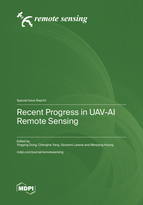Recent Progress in UAV-AI Remote Sensing
A special issue of Remote Sensing (ISSN 2072-4292). This special issue belongs to the section "AI Remote Sensing".
Deadline for manuscript submissions: closed (1 June 2023) | Viewed by 68072
Special Issue Editors
2. University of Chinese Academy of Sciences, Beijing 100190, China
Interests: vegetation quantitative remote sensing mechanism; remote sensing information analysis and application
Interests: precision agriculture; pest management; airborne; image processing; multispectral, hyperspectral and thermal imaging systems; unmanned aircraft systems; electronic and spectral sensors
Special Issues, Collections and Topics in MDPI journals
Interests: land degradation; vegetation mapping; satellite image analysis
Special Issues, Collections and Topics in MDPI journals
Interests: vegetation remote sensing; image processing; image classification; parameter mapping; system development; agricultural application
Special Issues, Collections and Topics in MDPI journals
Special Issue Information
Dear Colleagues,
The development of Unmanned Aerial Vehicles (UAV) and Artificial Intelligence (AI) techniques has drawn increasing interests and started a novel area of research applications. UAV imageries provide massive, wide-source, real-time, and high-resolution data for research community in face of precise or contingent requirements from different research fields such as energy, construction, security, agriculture, forestry, ecology, etc., which are followed by the usage of AI for effective and efficient data mining to obtain new, implicit, or useful information to support practical guidance and further applications. Combining the advantages of UAV and AI, automatic and fast processing and modelling can be achieved, instant and spatial and temporal varying knowledge of target areas can be obtained, and workload of operators and instructors will be greatly reduced. To build a UAV-AI system for solving complex problems, researchers will comprehensively complete tasks from data acquisition to model construction, and achievements in any tasks will promote the development of UAV-AI.
This Special Issue aims at studies covering uses of AI techniques to interpret data obtained by different UAV sensors. Research about the integration of multisource, multitemporal, or multiscale UAV imageries (e.g., multispectral, hyperspectral, thermal, LiDAR, etc.), and multiple AI fields such as deep learning, reinforcement learning, and federated learning, aimed at tackling the challenges or bottleneck problems from various fields are welcome. Articles may address, but are not limited, to the following topics:
- Data processing (multispectral, hyperspectral, thermal, LiDAR, etc.)
- Real-time object detection, counting, segmentation and tracking
- Change detection in land, forest, grass
- Pests, disease, and other disasters monitoring
- AI algorithms for UAV data
- UAV-AI system development
- UAV-AI applications
Dr. Yingying Dong
Dr. Chenghai Yang
Dr. Giovanni Laneve
Dr. Wenjiang Huang
Guest Editors
Manuscript Submission Information
Manuscripts should be submitted online at www.mdpi.com by registering and logging in to this website. Once you are registered, click here to go to the submission form. Manuscripts can be submitted until the deadline. All submissions that pass pre-check are peer-reviewed. Accepted papers will be published continuously in the journal (as soon as accepted) and will be listed together on the special issue website. Research articles, review articles as well as short communications are invited. For planned papers, a title and short abstract (about 100 words) can be sent to the Editorial Office for announcement on this website.
Submitted manuscripts should not have been published previously, nor be under consideration for publication elsewhere (except conference proceedings papers). All manuscripts are thoroughly refereed through a single-blind peer-review process. A guide for authors and other relevant information for submission of manuscripts is available on the Instructions for Authors page. Remote Sensing is an international peer-reviewed open access semimonthly journal published by MDPI.
Please visit the Instructions for Authors page before submitting a manuscript. The Article Processing Charge (APC) for publication in this open access journal is 2700 CHF (Swiss Francs). Submitted papers should be well formatted and use good English. Authors may use MDPI's English editing service prior to publication or during author revisions.
Keywords
- unmanned aerial vehicles
- artificial intelligence
- data fusion
- data mining
- UAV-AI algorithms
Benefits of Publishing in a Special Issue
- Ease of navigation: Grouping papers by topic helps scholars navigate broad scope journals more efficiently.
- Greater discoverability: Special Issues support the reach and impact of scientific research. Articles in Special Issues are more discoverable and cited more frequently.
- Expansion of research network: Special Issues facilitate connections among authors, fostering scientific collaborations.
- External promotion: Articles in Special Issues are often promoted through the journal's social media, increasing their visibility.
- Reprint: MDPI Books provides the opportunity to republish successful Special Issues in book format, both online and in print.
Further information on MDPI's Special Issue policies can be found here.
Related Special Issue
- Recent Progress in UAV-AI Remote Sensing II in Remote Sensing (6 articles)







